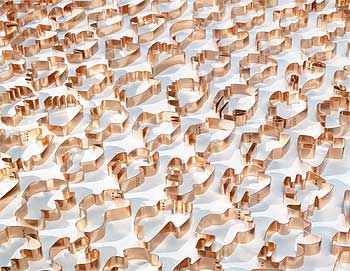The above video is excerpted from the Season 5 episode Systems, premiering on Wednesday, October 28, 2009 at 10pm (ET) on PBS (check local listings). Systems features four artists — John Baldessari, Kimsooja, Allan McCollum, and Julie Mehretu — who invent new grammars and logics, finding comfort in some systems while rebelling against others in today’s supercharged, information-based society.
Who is Allan McCollum and what does he have to say about systems?
Allan McCollum was born in Los Angeles in 1944; he lives and works in New York. In his twenties, McCollum briefly considered a career in theater, then attended trade school to study restaurant management and industrial kitchen work. In the late 1960s, he began to educate himself as an artist. Applying strategies of mass production to hand-made objects, McCollum’s labor-intensive practice questions the intrinsic value of the unique work of art. McCollum’s installations—fields of vast numbers of small-scale works, systematically arranged—are the product of many tiny gestures, built up over time. Viewing his work often produces a sublime effect as one slowly realizes that the dizzying array of thousands of identical-looking shapes is, in fact, comprised of subtly different, distinct things. Engaging assistants, scientists, and local craftspeople in his process, McCollum embraces a collaborative and democratic form of creativity. His drawings and sculptures often serve a symbolic purpose—as surrogates, faithful copies, or stand-ins for people—and are presented theatrically, transforming the exhibition space into a laboratory where artifice and context are scrutinized. Economical in form, yet curious in function, his work and mechanical-looking processes are infused with humor and humility.
On the subject of systems in art, McCollum describes how he creates low-tech combinatorial systems to generate projects on a massive scale (in the forthcoming Season 5 book):
The Shapes Project (2005) is the first computer project that I’ve done. It’s all done with Adobe Illustrator, and I learned only the things I needed to know to do it. I don’t know how to program or create any kind of database that generates anything. What I do is very simple, like what I’ve been doing in combinatorial projects for twenty-five years or even longer. All my projects have had combinatorial elements where I’m taking a vocabulary of parts and putting them together to make something else, which is very computer-like, but there was never a computer involved before.
What I’m doing is incredibly simple. It’s childlike; anyone could do what I’m doing. The hard part is having the patience (and a boring, compulsive personality) that allows me to keep doing it over and over and over again. So from four shapes I can make around 200-or-so million unique shapes. But there’s another system where I use six shapes. Once you start using that, you can produce 60 billion shapes. This is consistent with wanting to make a shape for everybody on the planet. I had to come up with a system that not only created enough unique shapes for everyone on the planet, but I wanted there to be enough (even in fifty years when there are billions more people) to play with and experiment with. So I went way overboard.
What happens in Allan McCollum’s segment in Systems this October?
Allan McCollum’s segment begins with his uncle Jon Gnagy’s 1950s television program Learn to Draw. Crediting his uncle’s demonstrations as an early influence, McCollum says “whenever I design a project it’s in my head…that I would be able to show someone else how to do it.”
Describing his aesthetic motivation with the paradox of “wanting to try to work in quantities…and make things that are singular and unique at the same time,” the viewer travels with the artist and his team of studio assistants to the 28th São Paolo Bienal (2008) for the installation of Drawings (1988)—1,800 hand-stenciled, graphite pencil works. McCollum describes devising “a system that would produce a shape for everybody on the planet.” To make The Shapes Project (2005), the artist developed a set of unique forms that, when fully combined, results in 60 billion individual shapes. McCollum later collaborated with four remote home businesses in Maine, whom he only talked to via email and phone, to produce collections of silhouettes, rubber stamps, wood ornaments, and copper cookie cutters. The resulting Shapes from Maine (2009) at Friedrich Petzel Gallery in New York consists of over 2,200 individual hand-crafted objects, each its own one-of-a-kind shape.

Allan McCollum. "Shapes from Maine: Shapes Copper Cookie Cutters," 2005/2008. Polished copper, 5 1/2 x 3 2/3 x 1 inches each, each unique, formed in copper by hand. Produced in collaboration with Holly and Larry Little, founders of Aunt Holly's Copper Cookie Cutters, Trescott, Maine. Photo by Lamay Photo, © Allan McCollum, courtesy Friedrich Petzel Gallery, New York.
What else has McCollum done?
Allan McCollum has had more than 100 solo exhibitions in Europe and the United States, where his work has appeared in major exhibitions at the Metropolitan Museum of Art, New York (2009); Museum of Modern Art, New York (most recently in 2007); and the Guggenheim Museum, New York (2004), among others. He has also participated in many international exhibitions, most recently at the Bienal de São Paulo (2008). Recent solo exhibitions include Friedrich Petzel Gallery, New York (2009); Barbara Krakow Gallery, Boston (2008); and Musée d’art moderne et contemporain, Geneva (2006), among others. Allan McCollum lives and works in New York.
Where can I see more of McCollum’s work between now and the Art21 premiere this October?
Allan McCollum is represented by Friedrich Petzel Gallery in New York. The artist also maintains an extensive website of his own works.
What’s your take on McCollum’s inclusion in Season 5?
Tell us what you think by leaving a comment below!




Pingback: What’s Cookin at the Art21 Blog: A Weekly Index | Art21 Blog